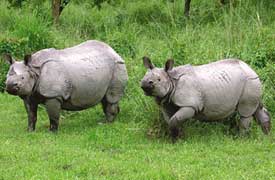Whoever started the rumour
that Rhino horns have medicinal properties needs to be run down by a
Rhino-stampede! How dare he float such a supposition without scientific proof?
Look what he’s done. Even though science clearly says a Rhino-horn is not
medicinal, people in this day and age are still hunting and killing Rhinos for
their horns – simply based on a rumour and nowadays – a superstition. The outcome?
World Rhino Population in 1970
– 85,000.
World Rhino Population in
2012 – 11,000.
90% reduction in just 40
years!
Do the math. How long would
it take us to completely wipe out this species? And any guesses as to how long
the Rhinos have been on this planet?
So before the humans do away
with this species on this planet, you may want to visit the Rhino in its
natural habitat. Here are the best options in India:
·
Kaziranga National Park in Assam – 430 square
kms – home to the largest population of Rhinos in India - 86% of India’s Rhinos
– about 1900 Rhinos found here. This population of Rhinos is also two-thirds of
World population of Rhinos!
·
Pobitora Wildlife Sanctuary – 39 square kms –
home to the second largest population of Rhinos in India. Rhino-breeding is
also in progress at this Sanctuary.
·
Orang National Park in Assam – 79 square
kilometres – home to the third largest population in India.
·
Manas National Park in Assam - 2837 square
kilometres – home to the fourth largest Rhino population in India.
And here’s a teaser to get
you going….
·
The Indian Rhinoceros can weigh between 1600 –
4000 kgs and is the 4th largest land animal which can grow up to a
height of 6 feet.
·
It is strictly herbivorous.
·
He can race upto a speed of 48 kms per hour.
·
The Indian Rhino has a single horn made of
keratin – same substance that makes our hair and nails. The Rhino’s horn is mistaken
for being medicinal and is sold in the Asian black market. This misunderstanding
cost the lives of over 70,000 Rhinos in 40 years.
And
the following is the best reason why we ought to let the Rhinos live longer on this
planet.
·
While the humans (Homo-sapiens) can take
trace their origins back to about 3 million years, the Rhinos have walked this
planet for 50 million years!
What you can do to help?
·
Contribute money towards the efforts of saving the Rhino.
Check online for the sites.
·
Spread the word about saving Rhinos. Blog
about Rhinos.
·
Educate people about the misconception about
Rhino Horns.
 |
| Rhino horns sold in black market for which rhinos are hunted and killed. |
Pix courtesy: thehindu; sahealthblog; bengalnewz;


















